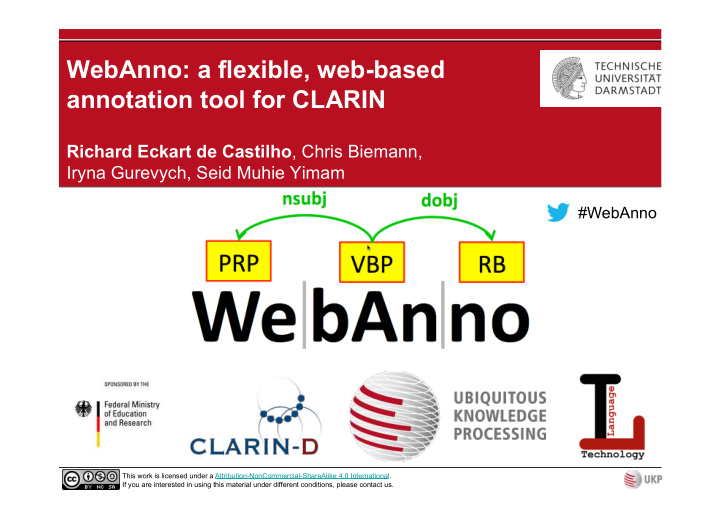



WebAnno: a flexible, web-based annotation tool for CLARIN Richard Eckart de Castilho , Chris Biemann, Iryna Gurevych, Seid Muhie Yimam #WebAnno This work is licensed under a Attribution-NonCommercial-ShareAlike 4.0 International. If you are interested in using this material under different conditions, please contact us.
WebAnno – an annotation tool for text � Team tool � Allows a distributed team of annotators to work on a corpus � Supports different roles within the team (e.g. user / manager) � Flexible � Multi-layer annotation with configurable annotation layers � Different annotation modes including correction and learning modes � Web-based � Available to annotators everywhere, no installation effort � All configuration performed through the web interface � Platform independent � Platform independent Java-based application � Open source � Allows the community to participate 24.10.2014 | Computer Science Department | UKP Lab | Richard Eckart de Castilho 2
WebAnno – an annotation tool for CLARIN � Developed based on the requirements of CLARIN F-AG 7… � Dipper et al. NoSta-D: A corpus of German non-standard varieties . Non-Standard Data Sources in Corpus-Based Research (2013): 69-76. � Benikova et al. NoSta-D Named Entity Annotation for German: Guidelines and Dataset. Proceedings of LREC. 2014. � … but also used beyond F-AG 7 � Pedersen et al. Semantic Annotation of the Danish CLARIN Reference Corpus. Proceedings 10th Joint ISO-ACL SIGSEM Workshop on Interoperable Sem. Annotation. 2014. � … used and recognized beyond CLARIN � Search “WebAnno” on Google Scholar � See our public users mailing list � WebAnno is the first annotation tool to supporting WebLicht TCF � Worked with TCF developers to improve TCF support updating files! � WebAnno team is constantly in touch with the community � Visit http://webanno.googlecode.com after the talk to participate in our survey! 24.10.2014 | Computer Science Department | UKP Lab | Richard Eckart de Castilho 3
Annotation examples Part-of-Speech & syntactic dependencies Named entities Co-reference 24.10.2014 | Computer Science Department | UKP Lab | Richard Eckart de Castilho 4
Main Menu � Annotate texts from scratch � Review and correct previously annotated documents � Employ integrated machine learning capabilities � Compare annotations from different annotators and merge them � Assign workload to annotators and monitor their progress � Create new projects � Create new user accounts 24.10.2014 | Computer Science Department | UKP Lab | Richard Eckart de Castilho 5
Workflow of a WebAnno project � d EXPORT FINAL DATASET t 24.10.2014 | Computer Science Department | UKP Lab | Richard Eckart de Castilho 6
Curation curator’s editor display annotators color-coded agreement highlight sentences with disagreement 24.10.2014 | Computer Science Department | UKP Lab | Richard Eckart de Castilho 7
Built-in layers vs. custom layers � WebAnno offers various built-in annotation layers � User can immediately start annotating � Only linguistic layers � Layer semantics are known � Custom layers allow WebAnno to be adapted to unforeseen tasks � Adapt to non-linguistic annotation tasks � Adapt to unforeseen linguistic annotation tasks � Layer semantics are unknown � Import/export of annotated data � Layers with known semantics convert from/to many formats (TCF, CoNLL, …) � Layers with unknown semantics convert from/to generic formats (XMI, …) 24.10.2014 | Computer Science Department | UKP Lab | Richard Eckart de Castilho 8
Layer types � Existing built-in layers were generalized into three layer types � Span layer – POS, lemma, named entity, … � Relation layer – Syntactic dependencies, … � Attaches to span annotations � Directed, reversible arcs � Chain layer – Co-reference chains, … � Undirected arcs � Layers can be further customized using “behaviours” � Character-based or token-based � Single/multiple token � Crossing of sentence boundaries � Stacking 24.10.2014 | Computer Science Department | UKP Lab | Richard Eckart de Castilho 9
Custom layer examples Semantic predicates and arguments (span/relation) Person (span) / Relationship (relation) 24.10.2014 | Computer Science Department | UKP Lab | Richard Eckart de Castilho 10
Custom layer examples Semantic predicates and arguments (span/relation) Person (span) / Relationship (relation) 24.10.2014 | Computer Science Department | UKP Lab | Richard Eckart de Castilho 11
Custom layer configuration Features Layers Control Controlled behavior vocabulary 24.10.2014 | Computer Science Department | UKP Lab | Richard Eckart de Castilho 12
Integrated machine-learning � Annotating data from scratch is more work than correcting � WebAnno learns from pre-annotated data and makes suggestions � Accept suggestions with a single click � Correct suggestions to improve training data 24.10.2014 | Computer Science Department | UKP Lab | Richard Eckart de Castilho 13
Example: Chunking Part-of-Speech POS tagged Externally pre- POS-tagger annotated training data text model secondary data Chunk- Data annotated annotated in WebAnno documents Chunk training Chunk Externally pre- Chunker annotated data suggestions model primary data 24.10.2014 | Computer Science Department | UKP Lab | Richard Eckart de Castilho 14
Automation configuration Secondary training data Primary training data Training data example 24.10.2014 | Computer Science Department | UKP Lab | Richard Eckart de Castilho 15
Deploy WebAnno as you need it click to start webanno-standalone.jar personal workstation on-premise group server migrate projects to come… cloud-based group server CLARIN infrastructure service 24.10.2014 | Computer Science Department | UKP Lab | Richard Eckart de Castilho 16
Where we want to go from here… � Extend the scope of WebAnno � Support for slot-based annotation layers (semantic annotations) � Tagset constraints � Support for more built-in linguistic layers � Improve continuously based on user feedback � More efficient annotation interface � Support for additional corpus formats � … your feedback? � Deploy as a CLARIN infrastructure service � CLARIN AAI support � Reduce administrative overhead for operators � Self-service for project managers 24.10.2014 | Computer Science Department | UKP Lab | Richard Eckart de Castilho 17
V i s i t m e i n d e t m h e o s e s s i #WebAnno o n ! http://webanno.googlecode.com 24.10.2014 | Computer Science Department | UKP Lab | Richard Eckart de Castilho 18
Recommend
More recommend